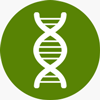 Background, initiator and participants
Background, initiator and participants
The project Genomchirurgie im gesellschaftlichen Diskurs (genome editing in societal discourse) aimed to stimulate public discussion regarding the ethical, legal and social aspects of new methods in genetic technology. The project is a cooperation between Wissenschaft im Dialog (WiD) and the German National Academy of Sciences – Leopoldina. It was funded by the German Federal Ministry of Education and Research as part of the research-funding program ELSA (ethical, legal and social aspects) in the life sciences.
 The question
The question
Conventional genetic technologies have been a subject of debate for many years and now the field is being revolutionised by new genome editing technologies, the most famous of which is the CRISPR-Cas9 system. The project focused on the medical applications of genome editing. Its target audiences included interested members of the public, school students, teachers, university students and apprentices, as well as stakeholders from politics, science and the media. These groups took part in various interactive activities that informed them about the new technology, and the opportunities and risks associated with it, with the goal of motivating them to develop their own opinions. 16 events took place from Autumn 2017 to Spring 2019 on topics about cancer treatment using somatic gene therapy, the use of gene drive against malaria vectors, and the opportunities and risks of genome editing.
 Method
Method
Wissenschaft im Dialog was responsible for 13 events across Germany designed for interested members of the public and school students. Some of the public events were examined from a social science point of view by external students and scientists.
As part of the project, a simulation game for school students was developed. It focused on gene drive technology, which might be used to control malaria by genetically modifying anopheles mosquitoes. After a testing phase involving four visits to schools of different types, the game was published as a toolkit. The toolkit includes presentations, a video, playing cards and work sheets, which allowed teachers to run the game independently with their students.
Five “lower house debates” targeting the "general public" were arranged to provide an opportunity to discuss genome editing. Two experts, one for the natural scientific part, one for the ethical or legal part, introduced the topic, then joined the audience for a debate focused on specific questions. The participants showed their opinion on each question by changing seats.
Three further public events took the form of a simulation game about cancer treatment using somatic gene therapy. During the game, participants engaged intensively with a hypothetical situation about a cancer patient who is unsure whether a new gene therapy using CRISPR-Cas9 is the right choice for her. The audience received expert input and support from moderators.
Leopoldina was in charge of three events for journalists and researchers, and political and scientific stakeholders in Halle/Saale and Berlin. In two training seminars organised by Leopoldina Journalist Collegium, journalists and editors joined scientists from the fields of biology, medicine, ethics and the law to elaborate in-depth insights into the specialist field of genome editing from multiple perspectives. The goal was to raise awareness of this complex topic among journalists and to encourage qualified media coverage. Within the framework of the workshop, a lower house debate was organised and attended by Leopoldina members and experts from hospitals, health care administration, medical societies, and patient associations.
The final workshop for stakeholders from all the target groups aimed to present and discuss the findings of previous events and to enable the participants to gain new perspectives through group discussions. In advance, masters’ students in the social sciences had the opportunity to study the events to determine how the participants reacted to the interactive event formats. Their findings were discussed at the workshop. The summarising documentation was made available at the end of the project.
Project website (German): www.genomchirurgie.de
 Notable features and lessons learned
Notable features and lessons learned
The different event formats tested in the project had different strengths and weaknesses making them suitable for different audiences and purposes. The corresponding advertising measures should be well planned and widely spread.
“Lower house debates” are suitable for large audiences (up to 100 people) and for audiences with little or no prior knowledge of the topic. In comparison to a podium discussion, lower house debates are much more interactive and allow more people to speak. An experienced moderator is required, and the experts should be well briefed.
Simulation games are suitable for smaller groups (max. 50 people) and usually attract participants with a pre-existing interest in the topic. They run for longer and enable a deeper and more detailed discussion of the issues. Developing a new game or adapting one to a new topic requires an investment of time and resources.
The key benefits of the seminars for journalists were to link science and media, to communicate scientific findings, and to facilitate joint discussions on opportunities and benefits of research. Also, the participants were able to make personal contacts and these relationships often support future reporting rather than immediate stories about the event itself.
It is not easy to encourage a representative sample of the population to discuss such complex issues together. For the most part, such formats reach committed and interested people. This series of events succeeded in attracting sufficient participation. The participants greatly appreciated the offer of an evening event on the topic of genome editing; the appetite for information and discussion was high.
Impact of the project
All participants of the stakeholder workshop stressed the importance of such participatory events and expressed their desire for additional thematically complementary debates (e.g. embryo research, germ line therapy, green genetic engineering, genetic engineering and farm animals). Care should be taken to ensure that complexity of debates remains manageable for the public. Overall, further and more diverse participants could also be included in the events.
The accompanying socio-scientific research examined the participation formats from different angles. The formats and insights gleaned can be used for future communication projects.



